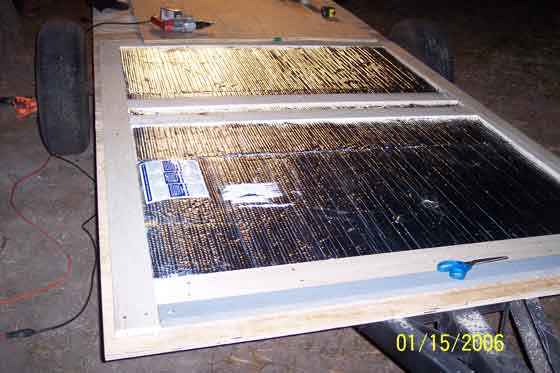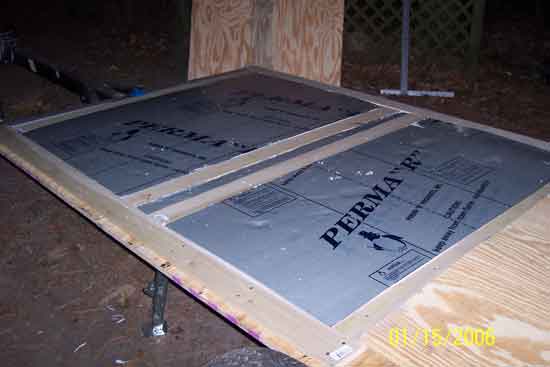Page 1 of 2
Wood - painting, coating, protecting, etc.

Posted:
Mon Jan 30, 2006 11:28 amby EZ
While building a wooden (composite) sailboat a few years back I did a lot of research on finishing. I was on a tight budget then as well and I came across the article linked below by Dave Carnell about latex paint for boats. Thought it might be useful information for someone along the way. I am going to paint the bottom of my camper floor with whatever latex primer and paint that I have laying around. No mess, no smell, no waiting to dry and free.
http://www.angelfire.com/nc3/davecarnell/articles.html#A1

Posted:
Mon Jan 30, 2006 12:24 pmby Ira
I'm sure it'll be FINE! Are you going to insulate the floor?
If so, that's extra protection. If not, you can then always see what's going on down there and give it another coat down the road if you think it needs it.

Posted:
Mon Jan 30, 2006 2:42 pmby mbader

Posted:
Mon Jan 30, 2006 2:59 pmby EZ
Yes Ira, I will insulate the floor. It is too easy not to stick some pink foam underneath. Besides, I caught hell on this board last time I suggested I wouldn't, but that was when I thought I would have to build a "box" floor. And it would be crazy not to here in Minnesota as a few members pointed out....
This is fun!
Ed
Happy I said it

Posted:
Mon Jan 30, 2006 4:30 pmby Guy
Dear EZ,
Until now I was worried I insulted you by suggesting the insulation.


Posted:
Mon Jan 30, 2006 6:49 pmby EZ
No way Guy, I am a novice here and although I am doing my own thing building this camper all of my ideas are weighed against the experience here.
This is such a great forum. It is fun as a rookie on the board to see the guys who are more familiar banter about various ideas or past jokes. This board and the people on it are one of the things that make the internet truly amazing. Ten or fifteen years ago this wouldn't have been possible.
Besides, I'm thicker skinned than that........

Ed

Posted:
Tue Jan 31, 2006 9:02 amby Ira
EZ, I don't know if you've seen any of my past posts about the surprise effect of insulation in my TD, but...
When I go to work on mine at the boatyard, and it's been like 90 degrees out and it's been baking in the sun all day...I open the door and it's COOL in there. REAL cool Yes, the insulation really DOES work both ways.
I did my floor insulation a little ass backward--I think. I think most people do it plain-side out, meaning the foil faces the cabin. I did it foil side DOWN, so it would reflect ground heat AWAY from the floor. (South Florida.)
What's weird about this is I think most people do it foil side out for the walls. Yet they do foil IN for the roof. Is there any logic to this at all? In my climate, I really didn't care--especially with 5000 btus of AC.
Also, since I only did 3/4" insulation on the floor and sides, I only used one layer of 3/4" in the roof as well, although my spar configuartion allowed for twice that.
I TRIED to get two layers of 3/4" in there for the roof, but without kerfing, try as I could, I couldn't get two layers to sit flush, so I just went with one.

Posted:
Tue Jan 31, 2006 6:52 pmby Joamon
Ira
I have yet to insulate but I bought it yesterday. (I realize from your posts your not the expert) But I have read when insulating its best not to leave dead air space because of condensation problems. Have you had any problems with this? I have some 1" some 3/4" and some 1/2" and I must admit I"m not looking foward to doing this. Also anybody know a good way to get insulation to stick to the underside of the floor should I decide to insulate it later?
Keith

Posted:
Tue Jan 31, 2006 9:04 pmby Ira
I don't have any dead space in my walls--stick framing is 3/4", and insulation is 3/4' thick.
Floor isn't an issue, and the insulation is wedged in there like a mother, and screwed in (plus washers).
As far as the roof goes, I guess I have dead space then. But never even thought that condensation would be a problem.

Posted:
Tue Jan 31, 2006 9:08 pmby toypusher
Joamon wrote:............ Also anybody know a good way to get insulation to stick to the underside of the floor should I decide to insulate it later?
Just put some asphalt emulsion on and stick the insulation into it, then use screws with fender washers on them to make sure it stays. The insulation should be a tight fit to begin with and would say in place by itself until you hit the road. Make sure the screws are not too long that they go through the floor!



Posted:
Mon Feb 13, 2006 8:59 amby cracker39
I have to agree with Ira on which side the foil goes. Attics are insulated with a foil lining that is tacked to the trusses at the roof, to reflect the heat back out before it penetrates into the attic. For that reason, being in Florida, my foil will be on the outside for all insulation. I am not concerned with reflecting heat back inside in cold weather. The foam will hold in what little heat I will need to add to the interior, if any. I want the heat from the hot sun reflected back outside.
As for dead spaces and condensation, I'd think if the interior and exterior skins are sealed properly, you wouldn't get any moisture inside the roof cavity. Most of the moisture problems you have inside a house come from moisture being put into the air from steam from cooking, showering, laundry, etc. You won't have any moisture generated inside a TD (unless you sweat a lot!!!). If the weather is hot and humid and you are using an AC, it will dehumidify the air anyway (and I will be using one). So, I will probably end up with some dead space inside my roof too, and I'm not concerned about it. I may get some of the bubble insulation and piece it where I have space left and then, I may just leave the spaces.

Posted:
Mon Feb 13, 2006 10:24 pmby cracker39
Ira, I looked at foam again today at HD. The 3/4" foil backed foam has a higher density than the plain foam (and R value of 5), but doesn't bend very easily. But, then, I had an idea. For the 1 1/2" curved sections on mine (the roof) I thought about two layers of the cheap bendable foam (R value of 3 per 3/4") with aluminum foil glued to the top of the outside piece. That should give the same results as the foil backed foam, and have more insulation R Value than the 3/4" walls. The cheap unlined foam will bend in a fairly tight curve, more than I'll have in my roof.

Posted:
Mon Feb 13, 2006 10:56 pmby critter
hey all,
in my build i used a layer of 3/4 and a layer of 1/2.fit great with 2/2 limber.i just glued them together.worked for me.


Posted:
Tue Feb 14, 2006 5:58 amby Sonetpro
I am agree with Dale and Ira. More concerned with heat in Texas. I am using 3/4 stick construction. I have foil facing both inside and out. Facing out is 1/4" foil bubble wrap and facing in is 1/2" foil faced panel.
I'm using 3/4" tounge and groove,3/4" stick amd 1/4" sandwich construction, sealed with boat bottom paint.



Posted:
Tue Feb 14, 2006 8:26 amby cracker39
I asked a clerk in HD about the foil bubble wrap and he had no clue as to what I was talking about. I looked really good in the insulation section, and I didn't see any either. I guess I'll check at Lowes. If I find it, I may use the same setup in my ceiling. Layer of bubble wrap and layer of foam, but I'll use the unfaced bendable foam on the inside. I don't see the need for foil on the inside face. Foil on the outside should reflect radiant heat, and the foam should stop, or at least slow down, heat absorption.




